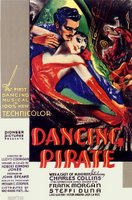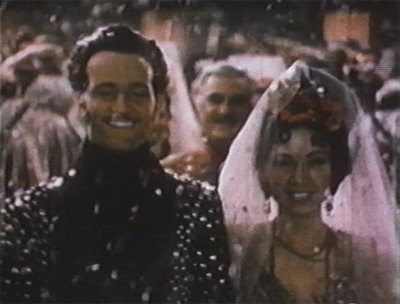Dancing Pirate
As noted at The American Widescreen Museum, very many early Technicolor movies had a Hispanic flavour, "perhaps inspired by the bright colors of the costumes" associated with Latin America. After two-strip (limited colour) efforts such as Rio Rita, the very first live-action full colour Technicolor movie, for instance, was the short La Cucaracha.
 And then, in 1936, along came Dancing Pirate, set, like the Zorro movies, in the Spanish California of the early nineteenth century.
And then, in 1936, along came Dancing Pirate, set, like the Zorro movies, in the Spanish California of the early nineteenth century.
Like Rio Rita and La Cucaracha, this too is a musical comedy. The dancing pirate of the title is no pirate, though he is mistakenly identified as one. Rather, he is a dance master from Boston named Jonathan Pride who sometime in 1820, while en route to his aunt's house for the weekend, is forced to join the crew of a buccaneer headed for the West Coast.
Once there, Pride slips away from his pirate companions, still clutching his overnight case and the umbrella he had intended to return to his long-suffering aunt. He makes his way to the village of Las Palomas, where the townspeople, under the bumbling leadership of alcalde Don Emilio José María Salazar y Perena, are readied to resist the expected pirate onslaught. Capturing the errant dance master, who is taken to be a pirate ringleader, the mayor declares glorious victory over the barbarian hordes, and prepares to hang his prize in the morning.
On the scaffold, however, Pride is asked to dance at the suggestion of the mayor's beautiful daughter, Serafina, who has an inkling that this pirate may not be all he seems. So dance he does.

What's more, Pride lets out that he has dedicated rather more of his life to teaching young women the waltz than to roaming the high seas. At the news that she could learn how to waltz from him, Serafina begs her father for a reprieve. And so the dancing pirate gains a stay of execution while he gives lessons in this daring dance--daring because it involves the man putting his arm around the woman's waist. Naturally enough, and as if to confirm the fears of the scandalized mayor, Serafina and Jonathan fall in love over the course of their lessons.
As if being on death row were not enough, more trouble is brewing in Las Palomas. A contingent of soldiers garrison themselves in the town, rather outstaying the hospitality shown them as they commandeer even the mayor's bath tub and hot water. It soon emerges, moreover, that their captain, Don Balthazar, has designs on both Serafina and the Perena's well-apportioned estate. As the captain threatens to have the dancing pirate killed, the mayor's daughter agrees to marry him on condition that he save her true lover. (Have we heard this story before, I wonder?)
Through all these travails, from impressment to the verge of execution, Pride remains curiously impassive, barely protesting his fate except in the most cautious expressions of polite umbrage. Though the waltz that he teaches instills a daring sensuality (it is, he reminds us, "an intimate dance"), the teacher himself is strangely affectless, detached from his situation. The villagers, though gradually won over to his charms, express increasing frustration at his lack of resolve. "It's too bad you haven't got any Spanish blood in you," an exasperated friendly innkeeper tells him, "You would die fighting for your woman." Even the ineffectual alcalde, giving his daughter away, rather hopes that her defeated suitor might hit the army captain over the head with his ever-present umbrella.
But Pride does have a plan up his sleeve. Exiled from Las Palomas, he recruits a group of indigenous warriors to fight for his cause. Unfortunately, they are rather too pacific, and still have to master a war dance. So the dancing pirate steps in, and teaches them a dance that will whip them up to martial frenzy, so that soon they are headed back to the village to take on the Spanish army. Then, with the footsoldiers (literally) tied up, Pride takes on Don Balthazar, and what he doesn't know about fencing he more than makes up for with his balletic twists and turns. Finally, even the umbrella comes in handy as a foil for the captain's blade. With Balthazar defeated and sent packing, once again the wedding arranged by and for the dastardly usurper is transformed into the occasion to unite Anglo and Latina in a happy celebration of bicultural resolution.

Moreover, through the dance master's stay in the village, the melding of West Coast Latin and East Coast WASP (and, one should add, indigenous remnant) has effected also an affective modulation. Serafina has learned to revel in the fashionable intimacy that is the modern European waltz. Jonathan has leaned to live up to his surname and take hot-blooded Latin pride in himself and so master his fate. (And the Indians have been roused from their domesticated slumber, to be converted into effective fighters for American self-determination.)
In short, it is as though the ideal affective subject had to break from stifling tradition (habit) without losing fiery authenticity. That subjectivity can only be achieved through a combination of Anglo modernization and Latin spirit. On their own, each is ineffectual, and prey to tyranny: the first because it degenerates into lifeless courtesy; the second because it is all enthusiastic bluster without rational direction.
 And then, in 1936, along came Dancing Pirate, set, like the Zorro movies, in the Spanish California of the early nineteenth century.
And then, in 1936, along came Dancing Pirate, set, like the Zorro movies, in the Spanish California of the early nineteenth century.Like Rio Rita and La Cucaracha, this too is a musical comedy. The dancing pirate of the title is no pirate, though he is mistakenly identified as one. Rather, he is a dance master from Boston named Jonathan Pride who sometime in 1820, while en route to his aunt's house for the weekend, is forced to join the crew of a buccaneer headed for the West Coast.
Once there, Pride slips away from his pirate companions, still clutching his overnight case and the umbrella he had intended to return to his long-suffering aunt. He makes his way to the village of Las Palomas, where the townspeople, under the bumbling leadership of alcalde Don Emilio José María Salazar y Perena, are readied to resist the expected pirate onslaught. Capturing the errant dance master, who is taken to be a pirate ringleader, the mayor declares glorious victory over the barbarian hordes, and prepares to hang his prize in the morning.
On the scaffold, however, Pride is asked to dance at the suggestion of the mayor's beautiful daughter, Serafina, who has an inkling that this pirate may not be all he seems. So dance he does.

What's more, Pride lets out that he has dedicated rather more of his life to teaching young women the waltz than to roaming the high seas. At the news that she could learn how to waltz from him, Serafina begs her father for a reprieve. And so the dancing pirate gains a stay of execution while he gives lessons in this daring dance--daring because it involves the man putting his arm around the woman's waist. Naturally enough, and as if to confirm the fears of the scandalized mayor, Serafina and Jonathan fall in love over the course of their lessons.
As if being on death row were not enough, more trouble is brewing in Las Palomas. A contingent of soldiers garrison themselves in the town, rather outstaying the hospitality shown them as they commandeer even the mayor's bath tub and hot water. It soon emerges, moreover, that their captain, Don Balthazar, has designs on both Serafina and the Perena's well-apportioned estate. As the captain threatens to have the dancing pirate killed, the mayor's daughter agrees to marry him on condition that he save her true lover. (Have we heard this story before, I wonder?)
Through all these travails, from impressment to the verge of execution, Pride remains curiously impassive, barely protesting his fate except in the most cautious expressions of polite umbrage. Though the waltz that he teaches instills a daring sensuality (it is, he reminds us, "an intimate dance"), the teacher himself is strangely affectless, detached from his situation. The villagers, though gradually won over to his charms, express increasing frustration at his lack of resolve. "It's too bad you haven't got any Spanish blood in you," an exasperated friendly innkeeper tells him, "You would die fighting for your woman." Even the ineffectual alcalde, giving his daughter away, rather hopes that her defeated suitor might hit the army captain over the head with his ever-present umbrella.
But Pride does have a plan up his sleeve. Exiled from Las Palomas, he recruits a group of indigenous warriors to fight for his cause. Unfortunately, they are rather too pacific, and still have to master a war dance. So the dancing pirate steps in, and teaches them a dance that will whip them up to martial frenzy, so that soon they are headed back to the village to take on the Spanish army. Then, with the footsoldiers (literally) tied up, Pride takes on Don Balthazar, and what he doesn't know about fencing he more than makes up for with his balletic twists and turns. Finally, even the umbrella comes in handy as a foil for the captain's blade. With Balthazar defeated and sent packing, once again the wedding arranged by and for the dastardly usurper is transformed into the occasion to unite Anglo and Latina in a happy celebration of bicultural resolution.

Moreover, through the dance master's stay in the village, the melding of West Coast Latin and East Coast WASP (and, one should add, indigenous remnant) has effected also an affective modulation. Serafina has learned to revel in the fashionable intimacy that is the modern European waltz. Jonathan has leaned to live up to his surname and take hot-blooded Latin pride in himself and so master his fate. (And the Indians have been roused from their domesticated slumber, to be converted into effective fighters for American self-determination.)
In short, it is as though the ideal affective subject had to break from stifling tradition (habit) without losing fiery authenticity. That subjectivity can only be achieved through a combination of Anglo modernization and Latin spirit. On their own, each is ineffectual, and prey to tyranny: the first because it degenerates into lifeless courtesy; the second because it is all enthusiastic bluster without rational direction.
